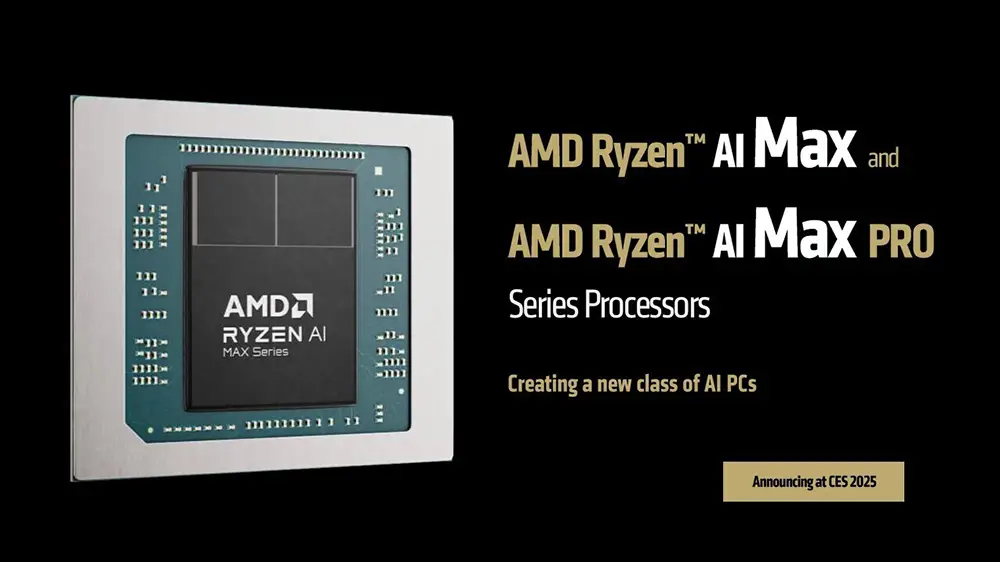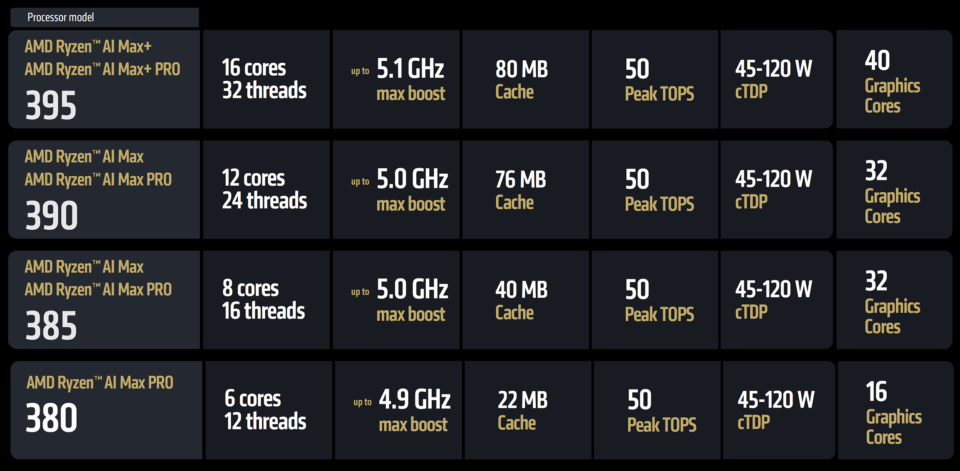Ryzen AI Max hardware is unique among the mobile platforms available today, as it pairs a powerful processor built on AMD’s latest-to-date Zen5 cores with a massive integrated graphics chip, with as many as 40 AMD RDNA3.5 Compute Units. There’s no other such chip available out there with this sort of iGPU, while on the CPU side, only the highest-tier Ryzen HX and Core HX/Core Ultra HX SKUs offer similar levels of performance.
Nonetheless, the Ryzen AI Max hardware is primarily meant as a standalone platform, with the AMD chip handling both CPU and graphics processing. That’s unlike AMD’s Strix Point and even Fire Range hardware, which are mostly paired with dedicated graphics from Nvidia, including RTX 5000 Blackwell chips for devices launched in 2025.
Down below, in the first part of the article, we’ll go through the particularities of this AMD Strix Halo hardware, our estimations on performance in actual tasks and games, which we’ll then update with actual performance benchmarks and findings once we get to properly test the devices built on this hardware.
In the second part of the article we’ll list all laptops and devices built on this AI Max Ryzen hardware, and specifically point out towards those the primarily stand-out as the best Ryzen AI Max implementations with their format, features, or potential capabilities.

AMD Strix Halo Ryzen AI Max APU lineup
These are the Ryzen AI Max APUs that will be implemented in devices this year, with Pro and non Pro variants for most SKUs. The Pros are meant for business/enterprise notebooks, while the others are for regular implementations. I’ve also included the Strix Point Ryzen 9 AI 370 in the table, to showcase the differences between the two platforms.
| Ryzen AI Max+ 395 | Ryzen AI Max 390 | Ryzen AI Max 385 | Ryzen 9 AI Max 380 | Ryzen 9 AI 370 HX | ||
| Build process | 4nm | |||||
| Generation | Zen 5 | Zen 5 | ||||
| TDP | 45-120W | 15+ W | ||||
| Cores/Threads | 16x Zen5, 32 Threads | 16x Zen5, 24 Threads | 8x Zen5, 16 Threads | 6x Zen5, 12 Threads | 4x Zen5, 8x Zen5c, 24 Threads | |
| CPU Max Boost | up to 5.1 GHz | up to 5.0 GHz | up to 5.0 GHz – Zen5 | up to 4.9 GHz – Zen5 | up to 5.1 GHz – Zen5, up to 3.3 GHz – Zen5c | |
| L2+L3 Cache | 80 MB | 76 MB | 40 MB | 22 MB | 36 MB | |
| Memory Type | LPDDR5x-8000, max 128 GB | DDR5-5600, LPDDR5x-8000 | ||||
| Graphics | Radeon 8060S, 40 CUs, RDNA3.5 | Radeon 8050S, 32 CUs, RDNA3.5 | Radeon 8050S, 32 CUs, RDNA3.5 | Radeon 8040S, 16 CUs, RDNA3.5 | Radeon 890M, 16 CUs, RDNA 3.5 | |
| Graphics Speed | up to 2800 MHz | up to 2800 MHz | up to 2800 MHz | up to 2800 MHz | up to 2900 MHz | |
| AI Engine | NPU – up to 50 TOPS, Total – up to 126 TOPS (Ryzen AI Max+ 395) | NPU – up to 50 TOPS Total – up to 80 TOPS | ||||

As mentioned earlier, all you should mostly need to know is that AMD Strix hardware is all about pairing a powerful processor with and an integrated graphics chip unlike anything offered before, for a unified solution. Of course, the performance differs significantly between the flagship Ryzen AI Max+ 395 and the bottom-tier Ryzen AI Max Pro 380, with a solid middle grounder in the Ryzen AI Max 385 that I’m specifically looking at seeing in action.
As far as that Ryzen AI Max+ 395 goes, my sources mention graphics performance somewhere between a mid-powered RTX 4060 and 4070. That’s impressive for an iGPU and 2.5-3x what something like a Radeon 890M can offer, or at least 2x what’s offered on Intel’s side by the Arrow Lake Core Ultra 200H chips with the faster Arc 140v iGPU.
But you should absolutely be aware that this Ryzen AI hardware can run at between 45-120W cTDP, and that means its actual capabilities are going to vary significantly between implementations. A more portable laptop chassis won’t offer the same potential as a beefier implementation.
Nonetheless, I am interested in how well this platform is going to scale down at lower power levels. Strix Point does very well, especially on the iGPU side, where the Radeon 890M at 20W still scores roughly 75-80% of its full potential at 45+W. But with these Ryzen AI Max SKUs and Radeon 8000 graphics, the differences are going to be most likely bigger.
Compared to AMD’s Strix Point hardware, which is implemented in quite a few thin-and-light designs either standalone or paired with Nvidia dGPUs, the Strix Halo APUs have a potential advantage in CPU processing power and a potential disadvantage in efficiency, since the platform doesn’t include any Zen5c cores, which should affect battery runtimes in comparison. GPU performance, on the other hand, that’s the real question here, especially in portable implementations that can’t physically get Nvidia graphics. That’s if they’ll exist at all, since the Ryzen AI Max APU is physically much larger than the regular chips normally implemented in mobile devices, which raises the question of motherboard design and cooling on a potential portable Strix Halo computers.
For a deeper look at the AMD platforms available for 2025 devices, I suggest going over this dedicated article on AMD Strix Point, Strix Halo, Krackan or Fire Range.
At the end of the day, objectively looking past the hype of having a unified AMD platform with these specs, the success of Strix Halo is up to the actual products that we’ll implement the hardware. Format and pricing are going to play a major role in steering potential buyers towards this platform over the multitude of others available out there, especially later in the year once the mid-tier RTX 5000 dGPUs get out. So far, there are very few actual products announced on this hardware, so we’ll see what we’ll actually get later in the year.
Complete list or AMD Strix Halo laptops (up to Ryzen AI Max+ 395)
This section lists all available/launched devices built on this Ryzen AI Max 300 hardware, although very few have been announced so far, but stay around for updates as new ones will be released.
So far, the ROG Flow Z13 gaming-tablet from Asus stole all thunders, as the only real product showcasing the platform at CES as an early working prototype that ran some games such as Black Myth: Wukong. The final products are coming later in the year, so stay around, we’ll have our reviews and coverage ready once allowed by embargos. What you should keep in mind is that the 2025 ROG Flow Z13 is a mid-range implementation of this hardware, with upwards of 80W sustained TDP, and that’s despite it’s compact size, due to the tablet format and highly advanced cooling. It’s going to cost north of 2k USD and 2.5K EUR in the Max 395+ version.
HP also quietly launched a Strix Halo ZBook Ultra 14 mobile workstation, with a premium and fairly compact 14-inch notebook format, a potential excellent allrounder in a top-tier traditional chassis. However, I’d only expect a mid-powered implementation of the AMD hardware in this chassis, and with some truly hefty prices of many thousands of dollars for the higher-tier configurations, given past experience with existing ZBooks.
We’re updating the list as it goes.
| Model | Screen | Hardware | Graphics | Weight | |
| Asus ROG Flow Z13 GZ302 | 13.3-inch 16:10 IPS touch | up to Ryzen AI Max 395+, max 128 GB LPDDR5x RAM | up to Radeon 8060S, 40CUs | 2.65 lbs / 1.2 kg – tablet only | |
| premium compact tablet format, all metal chassis, keyboard folio with keyboard/touchpad; 16:10 IPS touch display with 2.5K 180Hz 3ms panel, with touch and pen support; several configurations, Ryzen AI Max 390 or AI Max+ 395, up to 128 GB RAM LPDDR5x-8000 onboard, single M.2 2230 SSD storage; retail configurations only up to 32 GB RAM; dual-fan cooling design with vapor chamber, liquid metal; 70 Wh battery, 200W charger, dual-speakers, dual cameras | |||||
| Price: $2199 for the Ryzen AI Max+ 395 configuration | |||||
| HP ZBook Ultra 14 G1a | 14-inch 16:10 IPS matte or OLED touch | up to Ryzen AI MAX 395+, max 128 GB LPDDR5x RAM | up to Radeon 8060S, 40CUs | 3.3 lbs / 1.5 kg | |
| premium 14-inch mobile workstation chassis, compact design; 16:10 14-inch display with either 2K IPS matte or 2.8K OLED touch panels; white backlit keyboard; glass touchpad; good IO; multiple configurations, up to Ryzen AI Max+ 395 with 128 GB LPDDR5x-8533 memory, 1x M.2 2280 SSD; no exact details on the cooling so far, but expect dual-fan dual-heatsink with a bunch of heatpipes; 4x upfiring speakers, 2x mics, 5MPx IR camera; 74.5 Wh battery, 100/140W USC-C charger | |||||
| Price: tba in 2025 | |||||
Source: Ultra Book Review


